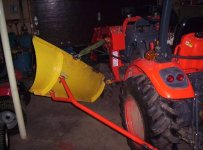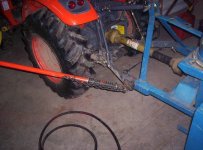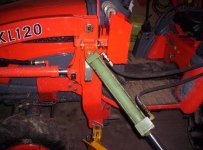Henro
Super Member
- Joined
- Jul 4, 2003
- Messages
- 5,003
- Location
- Few miles north of Pgh, PA
- Tractor
- Kubota B2910, BX2200, KX41-2V mini EX
<font color="blue"> I think that the float chain would bother me, but I don't know how I would change it right off. </font>
Jerry,
Here is one way and what I probably would do in Steve's application.
I would get a couple Hydraulic rated tee's and put them on the cylinder connectioins, and hook a hydraulic rated ball valve up so it is connected between the two cylinder ports. Valves rated for such service are avaiable for under $20.
The normal hose hookup would remain the same, but the addition of the ball valve would give a float option when the valve was opened. When the ball valve was closed it would have no affect on the operation and the system would work just as it does now.
If desired, the ball valve could be located remoted from the cylinder, where it would be easy to reach from the tractor seat.
Not sure if Steve needs or wants cylinder float in place of the float chain, but it looks to me it could be done effectively and cheaply if desired. Not quite as nicely as having a float detent on the control valve, but just as functional I would suspect.
I have not done this myself yet, but I see no reason why it would not work.
Just a thought... /forums/images/graemlins/smile.gif
Jerry,
Here is one way and what I probably would do in Steve's application.
I would get a couple Hydraulic rated tee's and put them on the cylinder connectioins, and hook a hydraulic rated ball valve up so it is connected between the two cylinder ports. Valves rated for such service are avaiable for under $20.
The normal hose hookup would remain the same, but the addition of the ball valve would give a float option when the valve was opened. When the ball valve was closed it would have no affect on the operation and the system would work just as it does now.
If desired, the ball valve could be located remoted from the cylinder, where it would be easy to reach from the tractor seat.
Not sure if Steve needs or wants cylinder float in place of the float chain, but it looks to me it could be done effectively and cheaply if desired. Not quite as nicely as having a float detent on the control valve, but just as functional I would suspect.
I have not done this myself yet, but I see no reason why it would not work.
Just a thought... /forums/images/graemlins/smile.gif


